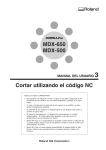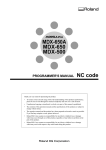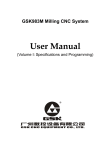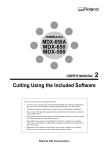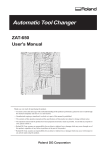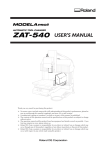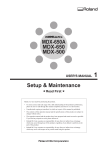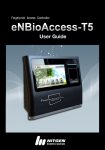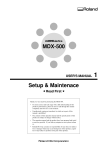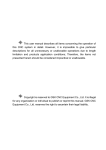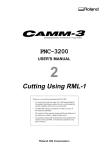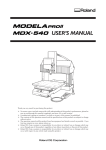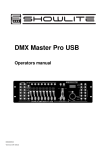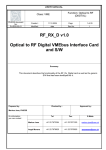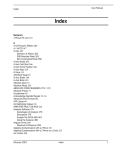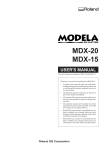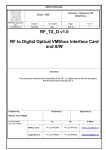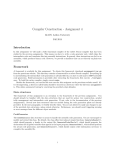Download USER`S MANUAL 3 Cutting Using NC Code
Transcript
MDX-650A MDX-650 MDX-500 USER'S MANUAL Cutting Using NC Code Thank you very much for purchasing the product. • To ensure correct and safe usage with a full understanding of this product's performance, please be sure to read through this manual completely and store it in a safe location. • Unauthorized copying or transferral, in whole or in part, of this manual is prohibited. • The contents of this operation manual and the specifications of this product are subject to change without notice. • The operation manual and the product have been prepared and tested as much as possible. If you find any misprint or error, please inform us. • Roland DG Corp. assumes no responsibility for any direct or indirect loss or damage which may occur through use of this product, regardless of any failure to perform on the part of this product. • Roland DG Corp. assumes no responsibility for any direct or indirect loss or damage which may occur with respect to any article made using this product. 3 Part 1 Basic Operation Contents Introduction ................................................................... 2 Setting the Instruction Set to NC Code ........ 2 Choosing the Spindle Type ........................... 2 Part 1 Basic Operation 1-1 Making Settings Using the Liquid-crystal Display ................... 4 MDX-650A/650 ........................................... 4 MDX-500 ..................................................... 5 1-2 Setting the Connection Parameters ........................ 6 1-3 Setting a Workpiece Coordinate System ................ 7 Workpiece Coordinates Not Specified ......... 7 Specified with G54 Through G59 ................ 8 Specified with G92 ....................................... 8 When Specifying EXOFS (External Workpiece-origin Offset) ..................... 9 1-4 Downloading Cutting Data ................................... 10 Postprocessing ............................................ 10 Selecting the Character Code ..................... 11 Using Subprograms .................................... 12 Using a Communications Application for NC ...... 14 Using the MS-DOS Prompt in Windows .... 14 Adjusting the Rotating Speed and Feed Speed ........ 15 Terminating Cutting .................................... 16 1-5 Finishing ............................................................... 17 Part 2 User's Reference 2-1 Cutting Area ......................................................... 19 MDX-650A/650 ......................................... 19 MDX-500 ................................................... 21 2-2 Operating Each Function ...................................... 23 Changing to Japanese Messages on the Liquid-crystal Display ......... 23 Performing Repeat Cutting ......................... 23 Pausing Operation and Adjusting the Rotating Speed and Feed Speed ..... 25 Terminating Cutting .................................... 25 2-3 Descriptions of the Display Menus ...................... 26 1 SPEED OVER RIDE .............................. 26 2 SPINDLE RPM ...................................... 27 3 MECHA MOVING ................................ 27 4 TOOL DIAMETER ................................ 27 5 MOVING MODE ................................... 28 6 USE CODE ............................................. 30 7 CONNECTION ...................................... 30 8 SERIAL PARAMETER ......................... 30 9 COMPENSATE ...................................... 31 10 SUB-PROGRAM ................................. 32 11 OTHERS ............................................... 33 12 Rotary Control (MDX-650A/650 only) ................. 35 13 ATC (MDX-650A only) ....................... 35 14 To Coordinate ....................................... 36 2-4 What to Do If... ..................................................... 37 When the machine does not work... ........... 37 When the spindle does not rotate ... ............ 37 Data cannot be sent ..................................... 38 The power does not come on... ................... 38 2-5 Error Messages ..................................................... 39 2-6 Other Messages .................................................... 41 2-7 Display Menus Flowchart .................................... 42 MDX-650A/650 ......................................... 42 MDX-500 ................................................... 47 Windows® and MS-DOS are registered trademarks or trademarks of Microsoft® Corporation in the United States and/or other countries. Other company names and product names are trademarks or registered trademarks of their respective holders. Copyright © 2001 Roland DG Corporation http://www.rolanddg.com/ 1 Part 1 Basic Operation Introduction Setting the Instruction Set to NC Code This chooses the instruction set immediately after switching on the power. When an instruction set has been chosen, it cannot be changed until the power is reset. 1 Switch on the power. After the opening message, the screen for selecting the instruction set appears. 2 Turn the dial to move the arrow to [NC-CODE], then press the [ENTER] key. Hit "ENTER" >NC-CODE Select MODE -<END>- Choosing the Spindle Type This sets the type of the installed spindle. If a high-torque spindle is installed, choose [HIGH TORQUE]. If a high-speed spindle is installed, choose [HIGH SPEED]. An incorrect selection may result in insufficient power to the motor and make normal cutting impossible, or conversely may apply power beyond the rated capacity to the motor and cause an error to be displayed during cutting. 1 If the display shows coordinates, press the [ENTER] key to display the main menu. *X Z 0 0 Y 0 5000 RPM >1 SPEED OVER RIDE 2 SPINDLE RPM 2 Part 1 Basic Operation 2 Turn the dial to move the arrow to [OTHERS], then press the [ENTER] key. >11 OTHERS 12 To Coordinate 3 Turn the dial to move the arrow to [SPINDLE UNIT], then press the [ENTER] key. 11>2 SPINDLE UNIT 3 BUZZER 4 Turn the dial to move the arrow to [HIGH TORQUE] or [HIGH SPEED], then press the [ENTER] key. The selected mode is enclosed in angle brackets. 11-2 SPINDLE UNIT <HIGH TORQUE> or [HIGH SPEED] * To go back to the main menu, press the [EXIT] key several times. 3 Part 1 Basic Operation Part 1 Basic Operation 1-1 Making Settings Using the Liquid-crystal Display MDX-650A/650 *X Z 0 0 Pressing the [ENTER] key at this time displays the menu. Y 0 S50 OFS You can move the tool or change the spindle speed or display by turning the dial while coordinate values are displayed. To move the tool, use the [JOG] key to choose an axis (either [X], [Y], or [Z]), then turn the dial. To change the spindle speed, choose [S??], then turn the dial. (The actual spindle speed is 100 times the displayed value.) At this time, a [*] (asterisk) appears next to the chosen item. Main Menu >1 SPEED SETTING 2 SPINDLE RPM Turn the dial to move the arrow ( ) to the item whose setting you want to make. >8 SERIAL PARAMETER 9 COMPENSATE 8>1 STOP BIT 2 DATA BIT Turn the dial to move the arrow ( ) to the item whose setting you want to make. Press the [ENTER] key. 8>3 PARITY BIT 4 BAUD RATE The value (or selection choice) enclosed in angled brackets (< >) indicates the current setting. 8-3 PARITY BIT <NONE> Press the [EXIT] key to return to the previous screen. Turn the dial to change the setting. Press the [ENTER] key. 8-3 PARITY BIT EVEN Press the [EXIT] key to return to the previous screen. Press the [ENTER] key. 8-3 PARITY BIT <EVEN> Angle brackets (< >) are displayed. 4 Part 1 Basic Operation MDX-500 *X Z 0 0 Y 0 5000 RPM Pressing the [ENTER] key at this time displays the menu. You can move the tool or change the spindle speed by turning the dial while coordinate values are displayed. To move the tool, use the [JOG] key to choose an axis (either [X], [Y], or [Z]), then turn the dial. To change the spindle speed, choose [??00 RPM], then turn the dial. At this time, a [*] (asterisk) appears next to the chosen item. Main Menu >1 SPEED SETTING 2 SPINDLE RPM Turn the dial to move the arrow ( ) to the item whose setting you want to make. >8 SERIAL PARAMETER 9 COMPENSATE 8>1 STOP BIT 2 DATA BIT Turn the dial to move the arrow ( ) to the item whose setting you want to make. Press the [ENTER] key. 8>3 PARITY BIT 4 BAUD RATE The value (or selection choice) enclosed in angled brackets (< >) indicates the current setting. 8-3 PARITY BIT <NONE> Press the [EXIT] key to return to the previous screen. Turn the dial to change the setting. Press the [ENTER] key. 8-3 PARITY BIT EVEN Press the [EXIT] key to return to the previous screen. Press the [ENTER] key. 8-3 PARITY BIT <EVEN> Angle brackets (< >) are displayed. 5 Part 1 Basic Operation 1-2 Setting the Connection Parameters Connection with a parallel cable is called a “parallel connection,” and connection with a serial cable is called a “serial connection.” Make the appropriate settings on both the computer and the machine to configure the equipment for the type of connection that has been made. To make the settings on the computer, refer to the manual for the computer or the software in use. 1 Press the [EXIT] key to display the main menu. 2 Turn the dial to move the arrow to [CONNECTION], then press the [ENTER] key. >7 CONNECTION 8 SERIAL PARAMETER 3 Turn the dial to choose [AUTO], then press the [ENTER] key. 7 CONNECTION 4 Press the [EXIT] key once to return to the screen at right. >7 CONNECTION 8 SERIAL PARAMETER 5 Turn the dial to move the arrow to [SERIAL PARAMETER], then press the [ENTER] key. >8 SERIAL PARAMETER 9 COMPENSATE 6 Turn the dial to move the arrow to the item you want, then press the [ENTER] key. 8>1 STOP BIT 2 DATA BIT 7 Turn the dial to choose a value (or selection), then press the [ENTER] key. 8-1 STOP BIT 6 <AUTO> For serial connection only <1> Part 1 Basic Operation 1-3 Setting a Workpiece Coordinate System The workpiece coordinate system is for machining loaded cutting material. Set the origin point at where you want on the workpiece. The program assumes that the origin is set with the machine. Before making the setting, check the program. This section describes the following three cases. Workpiece coordinates not specified Specified with G54 through G59 Specified with G92 When specifying EXOFS (External Workpiece-origin Offset) Workpiece Coordinates Not Specified When workpiece coordinates are not specified in the program, the workpiece coordinates set with the machine are used. The substituted workpiece coordinate system is G54. The G54 workpiece-coordinate origin point is set as follows. This explanation assumes that the origin point for the workpiece coordinate system is set at the front-left corner of the material 1 Press the arrow keys and the Tool up/down keys to move the cutting tool to a position close to the front left corner of the workpiece. 2 Use the [JOG] key to move the on-screen [*] to [X], [Y], or [Z]. 3 Rotate the dial to move the tool a little at a time. 4 Repeat steps 2 and 3 to align the tool at the front-left corner of the material to be machined. *X Z 0 0 Y 0 ....... 7 Part 1 Basic Operation 5 Press the [XY/A] key (If you're using MDX-500, press [XY] key). The screen at right appears. >1 Set G54(XY) 2 Set G55(XY) 6 Turn the dial to move the arrow to [SET G54(XY)], then press the [ENTER] key. The origin point for the X and Y axes is set at the present tool position. >1 Set G54(XY) 2 Set G55(XY) 7 Press the [Z] key. The screen at right appears. >1 Set G54(Z) 2 Set G55(Z) 8 Turn the dial to move the arrow to [SET G54(Z)], then press the [ENTER] key. >1 Set G54(Z) 2 Set G55(Z) Specified with G54 Through G59 When the workpiece coordinates are specified with G54 through G59, all workpiece coordinates stated in the program are set with the machine. For information about how to make the setting, see the previous section. The previous section describes how to make the G54 setting, but you can also make the settings for other workpiece coordinates in the same way. The setting for EXOFS (external workpiece origin offset) is also made in the same way. For a detailed description of G54 through G59, refer to the "NC Code Programmer's Manual." Specified with G92 G92 sets the current tool location to a desired location on a workpiece coordinate system. Normally, this is done by moving the tool to the location to become the workpiece-coordinate origin point, then executing G92X0Y0Z0. Tool Z Y 10.0 Executing G92X20.0Y15.0Z10.0 sets the coordinate system taking this as the origin point. Z 15.0 20.0 X Y X Move the tool to the starting point assumed by the program before sending the data. This example assumes that the front-left corner of the workpiece is to be specified as the origin point for the workpiece coordinate system. 8 Part 1 Basic Operation 1 Press the arrow keys and the Tool up/down keys to move the cutting tool to a position close to the front left corner of the workpiece. 2 Use the [JOG] key to move the on-screen [*] to [X], [Y], or [Z]. 3 Rotate the dial to move the tool a little at a time. 4 Repeat steps 2 and 3 to align the tool at the front-left corner of the material to be machined. *X Z 0 0 Y 0 ....... When Specifying EXOFS (External Workpiece-origin Offset) This is similar to the setting method for G54. Turn the dial to move the arrow to [SET EXOFS], then press the [ENTER] key. If you’re using the MDX-650A/650, you can display the set coordinate values of the coordinate systems. At the coordinate-view screen, press the [JOG] key and move the on-screen [*] to the [OFS, G54-59] at the lower right. Turn the dial to choose the coordinate system to display, then press the [ENTER] key to enable the setting. 9 Part 1 Basic Operation 1-4 Downloading Cutting Data Do not insert the fingers between the XY table and base or between the head and Z cover. Do not insert the fingers between the T-slot table and arms or between the head and Z cover. Doing so may result in injury. The fingers may be pinched, resulting in injury. Head Z cover T-slot table Arm Do not operate beyond capacity or subject the tool to undue force. The tool may break or fly off in a random direction. If cutting beyond capacity is mistakenly started, immediately turn off the switch. Before Sending the Data Postprocessing When a program has been created with general-use CAM software, it may need to be rewritten using NC codes that the cutting machine supports. This is called postprocessing. Postprocessing eliminates code that the cutting machine does not support, and converts the program to one that the target machine can execute. For more information about postprocessing, see the "Code Conversion Table" and "Program Statements" below. For information on how to make settings, see the documentation for the CAM software you're using. 10 Part 1 Basic Operation Code Conversion Table Before conversion After conversion Program Number (O) Address P for Subprogram Call (P) Subprogram Call (M98) End of Subprogram (M99) End of Program (M30) Address D for Cutter Compensation (D) Address X (X) Address Y (Y) Address Z (Z) Address A (A) O P M98 M99 M30 D X Y Z A *Available only when the optional rotary axis unit is installed Program Statements (for Reference) Enter the following codes at the beginning and end of the program (or subprogram). % G90G17G00Z? X0Y0 M03 ••••• a program for cutting ••••• G00Z? X0Y0 M05 M02 % Data start Set escape location which does not touch workpiece at [Z?] Move tool to XY origin Rotate spindle motor Set escape location which does not touch workpiece at [Z?] Return tool to XY origin Spindle rotation halt End of program Data end Caution 1 Use only codes listed in the "NC Code Programmer's Manual." Codes which are not listed there are ignored. 2 Codes for coolant control are not supported. However, on/off control of the EXT2 connector interlocked with spindle-rotation signals is possible. (For more information, refer to "Descriptions of the Display Menus.") 3 The setting for interpretation of the decimal point is made on the machine. Make the setting for the same interpretation assumed by the program. You can choose [NORMAL] or [CALCULATOR]. Selecting the Character Code The machine supports ASCII, ISO, and EIA character codes. Because the auto-recognition feature for character codes is set to "on" when shipped from the factory, so there is no need to select the character code. However, if "Parity Error" is displayed while receiving cutting data, refer to "Descriptions of the Display Menus" and make the setting for the character code. For more information about parity errors, see "Error Messages." 11 Part 1 Basic Operation Using Subprograms When programming using subprograms, you must register the subprograms with the machine before you send the main program. Register all subprograms called by the main program. If not registered, and error is displayed during cutting. Subprograms are stored in a buffer (temporary memory), so they disappear when you switch off the power. The method used to registering subprograms is as follows. 1 Turn the dial to move the arrow to [SUB-PROGRAM], then press the [ENTER] key. >10 SUB-PROGRAM 11 OTHERS 2 Turn the dial to move the arrow to [ENTRY SUBPROG.], then press the [ENTER] key. 10>1 ENTRY SUB-PROG. 2 SUB-PROG. SIZE If a subprogram has already been registered the screen at right appears. To register a new program, you must delete the program already registered. To delete it, press the [ENTER] key. Sub-Program Clear! Are You Sure?[ENTER] 3 The screen at right appears. 10-1 ENTRY SUB-PROG. Send Sub-Program 4 Operate the computer and send the subprograms. For more information on how to send data, take a look at the next section. During program registration, the screen at right is displayed. 10-1 ENTRY SUB-PROG. *Now Entry Sub-Prog. 5 When sending of one subprogram finishes, the screen changes to the one at right. To continue with sending the next subprogram, continue sending with the same setup, without pressing the [EXIT] key. You cannot register an addition subprogram after the [EXIT] key has been pressed. Adding will require reregistering all subprograms, including the one to be added. (The [*] flashes while data is being received.) 10-1 ENTRY SUB-PROG. Finish! Push [EXIT] After finishing sending all the subprograms needed to execute the program, press the [EXIT] key. The data space for saving programs, including the main program and any subprograms, is 2 MB (2,048 kB). The subprogram data area can be varied within a range of 0 to 1,536 kB, and the amount of space remaining after subtracting the subprogram area from the total space is the amount of space for the main program. (For example, if the subprogram space is set at 1,536 kB, the main program space is 512 kB.) To perform engraving using subprograms, you must register all subprograms. If there is not enough data space to register all subprograms, refer to the next page to free up more data space. However, even if the main program exceeds the remaining data space, you can still perform engraving for the sent data. Note that in this case, however, you cannot repeat engraving by pressing the [COPY] key. 12 Part 1 Basic Operation If There Is Not Enough Data Space to Register a Subprogram If the error at right appears while send data, it means that there is not enough data space, and a subprogram could not be stored. Stop sending data, and press the [EXIT] key. Data sent when the space was exceeded is all lost without being saved. To increase the amount of data space for storing subprograms, follow the steps below. 10-1 ENTRY SUB-PROG. Entry Area Nothing 1 Turn the dial to move the arrow to [SUB-PROGRAM], then press the [ENTER] key. >10 SUB-PROGRAM 11 OTHERS 2 Turn the dial to move the arrow to [SUB-PROG. SIZE], then press the [ENTER] key. 10>2 SUB-PROG. SIZE 3 To Main MENU 3 The screen at right appears. Press the [ENTER] key. All Buffer Clear! Are You Sure?[ENTER] 4 Turn the dial to change the data space, then press the [ENTER] key. 10-2 SUB-PROG. SIZE < 512 KByte> 13 Part 1 Basic Operation Sending Cutting Data Using a Communications Application for NC When using a communications application for NC programs to send data to the machine, make the settings as shown below. Communication programs that support Protocol A cannot be used. Use a program that supports Protocol B and also permits communication with RS and CD signals. (DC codes are not supported.) Character code Communication parameters DC code TV check Send buffer size Delimiter code Set this to match the setting on the machine. Set these to match the settings on the machine. The factory-default settings are bit rate of 9,600, no parity bit, data length of 8 bits, and 1 stop bit. Not supported (including XON/XOFF). Hardware control with RS and CS signals is performed. Not supported. Any setting is acceptable. [LF] for ISO and ASCII and [CR] for EIA Using the MS-DOS Prompt in Windows Use CAM software, a text editor, or the like to create the program, then save it with "test.nc" as the file name. In this case, you can send the program to the cutting machine by entering the following at the MS-DOS command line. Because the format differs according to the computer, refer to the computer's documentation for more information. Serial connection Parallel connection C:\> copy test.nc aux C:\> copy test.nc prn * When using a serial connection, set the same communication parameters for the computer and the machine. Make the settings for the communication parameters as shown below. 1 Start [MS-DOS Prompt] or [Command Prompt] in windows. 2 If the communication parameters for the COM1 port are as follows... Bit rate: Parity bit: Data bit length: Stop bit: 9,600 None 8 1 ...then type in the following. C:\WINDOWS> mode com1 baud=9600 parity=n data=8 stop=1 Waiting for Data During Serial Connection During a serial connection, when sending data that contains many fine line segments, operation may stop while cutting is in progress. At such times, the machine is waiting for the next portion of cutting data to be sent. You can avoid such interruptions by changing to a parallel connection to increase the data-transmission speed, or by increasing the amount of data stored in memory through such methods as sending cutting data for finishing while performing rough cutting. 14 Part 1 Basic Operation What You Can Do During Cutting Adjusting the Rotating Speed and Feed Speed The programmed rotating speed and feed speed can be adjusted while cutting is in progress. Below is a list of the items that can be adjusted. Positioning override This sets the G00 operating speed, with the maximum speed taken to be 100%. Cutting override This specifies a percentage of the feed rate set by programming (F code). According to this setting, the feed rate is set to a percentage of all feed rates specified by F codes. Cutting speed This specifies the feed rate for cutting in “mm/min.” units. If an F code is specified after restarting cutting, the speed specified by the F code is used. Spindle speed This sets the speed of the spindle. If an S code is specified after restarting cutting, the speed specified by the S code is used. 1 While operation is in progress, press the [PAUSE] key. Movement of the tool and table stops. Note that because this is not an emergency stop, movement may continue for two or three seconds before stopping. The screen at right appears. PAUSE>CONTINUE STOP 2 Turn the dial to move the arrow to the desired item, then press the [ENTER] key. PAUSE>CUT OVER RIDE CUT SPEED 3 Turn the dial to change the value, then press the [ENTER] key. To change another item, press the [EXIT] key, then repeat steps 2 and 3. PAUSE:CUT OVER RIDE <100 %> 4 Press the [EXIT] key to return to the screen at right. PAUSE>CONTINUE STOP 5 Turn the dial to move the arrow to [CONTINUE], then press the [ENTER] key. The paused state is canceled and cutting resumes. 15 Part 1 Basic Operation Terminating Cutting If you wish to correct the program and restart cutting from the beginning, or if the cutting data was different from what was desired, carry out the procedure below. 1 While operation is in progress, press the [PAUSE] key. Movement of the tool and table stops. Note that because this is not an emergency stop, movement may continue for two or three seconds before stopping. The screen at right appears. 2 Stop sending data from the computer 3 Turn the dial to move the arrow to [STOP], then press the [ENTER] key. Stop execution of the program. 16 PAUSE>CONTINUE STOP PAUSE>STOP CUT OVER RIDE Part 1 Basic Operation 1-5 Finishing Do not touch the tip of the blade with your fingers. Doing so may result in injury. Please use a vacuum cleaner to remove cutting dust. Do not use any blower like airbrush. Otherwise, dust spread in the air may harm your health. Do not touch the tool immediately after cutting operating stops. Use a commercially available brush to remove metal cuttings. The tool may have become hot due to friction heat and may cause burns if touched. Attempting to use a vacuum cleaner to take up metal cuttings may cause fire in the vacuum cleaner. After cutting has been finished, detach the tool, remove the material, and clean away chips. 1 Press the [EXIT] key to display the main menu. >1 SPEED OVER RIDE 2 SPINDLE RPM 2 Turn the dial to move the arrow to [MECHA MOVING], then press the [ENTER] key. >3 MECHA MOVING 4 TOOL DIAMETER 3 Turn the dial to move the arrow to [Go LIMIT Pos.], then press the [ENTER] key. 3>11 Go LIMIT Pos. 12 To Main MENU 4 Detach the tool. 5 Turn the dial to move the arrow to [Go VIEW Pos.], then press the [ENTER] key. 3 >3 Go VIEW Pos. 4 Go G54(XY) 17 Part 1 Basic Operation 6 Remove the material. 7 Use a commercially available vacuum cleaner to remove chips. 18 Part 2 User's Reference Part 2 User's Reference 2-1 Cutting Area MDX-650A/650 The maximum cutting area of the MDX-650A/650 is 650 mm x 450 mm x 155 mm (25-9/16 in. x 17-11/16 in. x 6-1/16 in.). The actual cutting area differs according to the type of spindle installed. When Use the High-torque Spindle (ZS-650T) When a high-torque spindle (ZS-650T) is installed, the range that you can actually cut (in the height direction) is subject to the following restrictions and is smaller than the maximum cutting range described earlier. 105 mm (4-1/8 in.) 80 mm (3-1/8 in.) 22 mm (7/8 in.) 155 mm(6-1/16 in.) (Z-axis movable range) - Length of the installed tool - Position of the XY table where the workpiece to cut is loaded - If using a spacer for the T-slot table (ZA-600/500 series), the height of the spacer X-rail bottom surface T-slot table upper surface when using a spacer (ZA-508) T-slot table upper surface 19 Part 2 User's Reference When Use the High-speed Spindle When a high-speed spindle is installed, the range that you can actually cut (in the height direction) is subject to the following restrictions and is smaller than the maximum cutting range. - Length of the installed tool - Position of the XY table where the workpiece to cut is loaded - If using a spacer for the T-slot table (ZA-600/500 series), the height of the spacer - If using a depth regulator nose, the stroke of the spindle due to the nut (approx. 5 mm) 130 mm (5-1/8 in.) 55 mm (2-3/16 in.) 112 mm (4-3/8 in.) 155 mm(6-1/16 in.) (Z-axis movable range) If not using the depth regulator nose (nut tightened) 12 mm (1/2 in.) 94.6 mm (3-3/4 in.) 5.4 mm (3/16 in.) 155 mm(6-1/16 in.) (Z-axis movable range) If using the depth regulator nose (nut loosened) X-rail bottom surface T-slot table upper surface when using a spacer (ZA-613) T-slot table upper surface 20 Part 2 User's Reference MDX-500 The maximum cutting area of the MDX-500 is 500 mm x 330 mm x 105 mm (19-5/8 in. x 12-15/16 in. x 4-1/8 in.). The actual cutting area differs according to the type of spindle installed. When Use the High-torque Spindle (ZS-500T) When a high-torque spindle (ZS-500T) is installed, the range that you can actually cut (in the height direction) is subject to the following restrictions and is smaller than the maximum cutting range described earlier. 55 mm (2-3/16 in.) 80 mm (3-1/8 in.) 22 mm (7/8 in.) 105 mm(4-1/8 in.) (Z-axis movable range) - Length of the installed tool - Position of the XY table where the workpiece to cut is loaded - If using a spacer for the T-slot table (ZA-600/500 series), the height of the spacer X-rail bottom surface T-slot table upper surface when using a spacer (ZA-508) T-slot table upper surface 21 Part 2 User's Reference When Use the High-speed Spindle When a high-speed spindle is installed, the range that you can actually cut (in the height direction) is subject to the following restrictions and is smaller than the maximum cutting range. - Length of the installed tool - Position of the XY table where the workpiece to cut is loaded - If using a spacer for the T-slot table (ZA-600/500 series), the height of the spacer - If using a depth regulator nose, the stroke of the spindle due to the nut (approx. 5 mm) 80 mm (3-1/8 in.) 55 mm (2-3/16 in.) 62 mm (2-7/16 in.) 105 mm(4-1/8 in.) (Z-axis movable range) If not using the depth regulator nose (nut tightened) 12 mm (1/2 in.) 44.6 mm (1-3/4 in.) 5.4 mm (3/16 in.) 105 mm(4-1/8 in.) (Z-axis movable range) If using the depth regulator nose (nut loosened) X-rail bottom surface T-slot table upper surface when using a spacer (ZA-508) T-slot table upper surface 22 Part 2 User's Reference 2-2 Operating Each Function Changing to Japanese Messages on the Liquid-crystal Display You can choose either English or Japanese for the display language. 1 Switch on the power while holding down the [EXIT] key. 2 Turn the dial to move the arrow to [JAPANESE], then press the [ENTER] key. 3 Messages on the display now appear in Japanese. >2 JAPANESE -<END>- * To return the display to English-language messages, carry out Step 1 again. When the language-selection menu appears (similar to the one in Step 1, but in Japanese), move the arrow to “English” and press the [ENTER] key. Performing Repeat Cutting The data buffer is the place where data received from the computer is stored temporarily. (The data in the data buffer can be erased by switching off the power or clearing the data. Pressing the [COPY] key calls up the all cutting data stored in the data buffer and executes the replotting procedure. When you perform replotting, clear the data from the data buffer before sending the cutting for replotting from the computer. 1 Press the [COPY] key. The screen at right appears. >1 COPY START 2 CLEAR COPY BUFFER 2 Turn the dial to move the arrow to [CLEAR COPY BUFFER], then press the [ENTER] key. Cutting data in the data buffer is lost. >2 CLEAR COPY BUFFER -<END>- 23 Part 2 User's Reference 3 Install the tool (blade) and load the material. Use the software to send the cutting data. 4 After cutting has finished, remove the cut material and load a new piece. Set the origin point if necessary. 5 Press the [COPY] key. Turn the dial to move the arrow to [COPY START], then press the [ENTER] key. 24 >1 COPY START 2 CLEAR COPY BUFFER Part 2 User's Reference Pausing Operation and Adjusting the Rotating Speed and Feed Speed The programmed rotating speed and feed speed can be adjusted while cutting is in progress. Below is a list of the items that can be adjusted. Positioning override This sets the G00 operating speed, with the maximum speed taken to be 100%. Cutting override This specifies a percentage of the feed rate set by programming (F code). According to this setting, the feed rate is set to a percentage of all feed rates specified by F codes. Cutting speed This specifies the feed rate for cutting in “mm/min.” units. If an F code is specified after restarting cutting, the speed specified by the F code is used. Spindle speed This sets the speed of the spindle. If an S code is specified after restarting cutting, the speed specified by the S code is used. 1 While operation is in progress, press the [PAUSE] key. Movement of the tool and table stops. Note that because this is not an emergency stop, movement may continue for two or three seconds before stopping. The screen at right appears. PAUSE>CONTINUE STOP 2 Turn the dial to move the arrow to the desired item, then press the [ENTER] key. PAUSE>CUT OVER RIDE CUT SPEED 3 Turn the dial to change the value, then press the [ENTER] key. To change another item, three the [EXIT] key, then repeat steps 2 and 3. PAUSE:CUT OVER RIDE <100 %> 4 Press the [EXIT] key to return to the screen at right. PAUSE>CONTINUE STOP 5 Turn the dial to move the arrow to [CONTINUE], then press the [ENTER] key. The paused state is canceled and cutting resumes. Terminating Cutting If you wish to correct the program and restart cutting from the beginning, or if the cutting data was different from what was desired, carry out the procedure below. 1 While operation is in progress, press the [PAUSE] key. Movement of the tool and table stops. Note that because this is not an emergency stop, movement may continue for two or three seconds before stopping. The screen at right appears. 2 Stop sending data from the computer 3 Turn the dial to move the arrow to [STOP], then press the [ENTER] key. Stop execution of the program. PAUSE>CONTINUE STOP PAUSE>STOP CUT OVER RIDE 25 Part 2 User's Reference 2-3 Descriptions of the Display Menus 1 SPEED OVER RIDE 1-1 CUT OVER RIDE 1-1 CUT OVER RIDE <100 %> Stored in Memory Yes Factory Default 100 Setting Range 0 to 200 Steps 1 Description This adjusts the cutting speed on the machine. This setting is made as a percentage, with the feed rate specified by program F-codes taken to be 100%. All codes that function at the cutting speed are affected. This setting can be used to make fine adjustments in the feed rate without altering programming. Note, however, that operation outside the machine's maximum or minimum speed is not possible, regardless of this setting. Also note that the feed rate changes in units of 60 mm/min. (1 mm/sec.). (However, the minimum speed can be set at 30 mm/min.) This setting can be made even while operation is paused. 1-2 CUT SPEED 1-2 CUT SPEED < 120 mm/min> Stored in Memory Yes Factory Default 120 Setting Range 30, 60 to 5100 Description This sets the default value for cutting speed. When an operation command using cutting speed is input when no cutting speed has been specified using F-codes, operation is carried out at this cutting speed. This setting can be made even while operation is paused. Cutting restarts at the speed that has been set, but if an F-code speed setting is encountered, the speed then changes to the value of the F-code setting. Steps 60 1-3 MOVE OVER RIDE 1-3 MOVE OVER RIDE <100 %> Stored in Memory Yes Factory Default 100 Setting Range 0 to 100 Steps 1 26 Description This sets a limit for positioning speed. When shipped from the factory, the machine is set at maximum speed. This setting is made as a percentage, with maximum speed taken to be 100%. This setting is applied to all codes which function at the positioning speed: G00, G80, G81, G82, G85, G86, and G89 are affected. This limitation of positioning speed causes cutting times to become longer. Positioning speed is not restricted by the limit speed setting for cutting speed. This setting can be made even while operation is paused. Part 2 User's Reference 2 SPINDLE RPM 2 SPINDLE RPM < 5000 RPM> Stored in Memory Yes Factory Default 3000 (High Torque) 5000 (High Speed) Description The speed of rotation specified by this setting is used when a spindle rotation command (M03) is input in a state where rotation has not been specified by an S-code. This setting can also be made while operation is paused. Cutting restarts at the speed that has been set, but if an S-code speed setting is encountered, the speed then changes to the value of the S-code setting. Setting Range 3000 to 12000 (High Torque) 5000 to 20000 (High Speed) Steps 1 3 MECHA MOVING Description 3 >1 Go EXOFS(XY) 2 Go EZOFS(Z) This performs movement to the specified location at the machine's highest speed. In the case of [Go EXOFS (Z)], however, the speed is as follows. (1) The speed specified by an F code in the program and by the machine's [CUT OVER RIDE] setting (2) The speed specified by the machine's [CUT SPEED] and [CUT OVER RIDE] settings 3 17 Go LIMIT Pos. 18 To Main MENU When both of these have been set, the one set last is valid. 4 TOOL DIAMETER 4 TOOL No.1 < 0 um> Stored in Memory Yes 4 TOOL No.2 < 0 um> Factory Default 0 4 TOOL No.3 < 0 um> Description This specifies the amount of offset set for cutter compensation and tool-length compensation. When G41 or G42 (cutter compensation) specifies an offset number which has not been set with G10, the value set on the machine is used. Setting Range 0 to 10000 Steps 10 27 Part 2 User's Reference 5 MOVING MODE 5-1 SPINDLE CONTROL 5-1 SPINDLE CONTROL <ON> Stored in Memory Yes Factory Default ON Selection Choices ON, OFF, EXTERNAL ONLY Description This chooses the method of control for the spindle motor. ON When a command to rotate the spindle is received, a rotate signal is issued to the internal spindle. A signal is also issued to the EXT2 connector at the same time. OFF Even when a command to rotate the spindle is received, not rotate signal is issued to the internal spindle circuit. Similarly, no signal is issued to the EXT2 connector. EXTERNAL ONLY Even when a command to rotate the spindle is received, not rotate signal is issued to the internal spindle circuit. A signal is issued only to the EXT2 connector. 5-2 CALC.TYPE VALUE 5-2 CALC.TYPE VALUE <NOT USE> Stored in Memory Yes Factory Default NOT USE Selection Choices NOT USE, F & IJKRXYZ CODE, F CODE, IJKRXYZ CODE Description This selects how numeric values are interpreted during real-number entry or integer entry. When set to [NOT USE], values during real-number entry are interpreted as millimeters or inches, and values during integer entry are interpreted as minimum-unit millimeters or inches. When set to [F & IJKRXYZ CODE], [F CODE], or [IJKRXYZ CODE], numerical values are always interpreted as millimeters or inches regardless of whether real-number entry or integer entry has been selected for the respective code. 5-3 SINGLE BLOCK 5-3 SINGLE BLOCK <OFF> Stored in Memory Yes Factory Default OFF Selection Choices OFF, ON Description When [ON] is specified, the program executes one block and then goes into a standby state. Pressing the [ENTER] key causes the next block to be executed. This makes it possible to carry out operations while change the contents of the program at each step. During single-block execution, it is not possible to switch the single block on or off. 5-4 OP. BLOCK SKIP 5-4 OP. BLOCK SKIP <ON> Stored in Memory Yes Factory Default ON Selection Choices ON, OFF 28 Description Optional block skip is a function that skips over desired blocks in a program (see the NC Code Programmer's Manual). When set to [OFF], no blocks specified by optional block skip are skipped. Part 2 User's Reference 5-5 OFFSET TYPE 5-5 OFFSET TYPE <TYPE A> Stored in Memory Yes Factory Default TYPE A Selection Choices TYPE A, TYPE B Description This selects the program path for outer-side travel when starting or ending cutter compensation. A case of shifting from a line to another line with travel on the outer side of an acute angle when cutter compensation starts is given as an example. For more information, refer to the NC Code Programmer's Manual. Outer-side Acute Angle From a line to a line -- Type A Start position a Amount of offset Programmed path Path traveled by center of tool From a line to a line -- Type B Amount of offset Start position a Programmed path Amount of offset Path traveled by center of tool 5-6 PROGRAM NUMBER 5-6 PROGRAM NUMBER <4 DIGITS> Stored in Memory Yes Factory Default 4 Selection Choices 4, 8 Description This chooses the number of digits for program numbers and sequence numbers. Choose the number of digits employed in the program. If the number of digits specified by the program differs from the number of digits specified by the machine, unexpected operation or errors may occur. If you are using subprograms, all programs used must employ the same number of digits. Programs that specify different numbers of digits must not be run at the same time. For more information about how to specify program numbers and sequence numbers, see the entries for M98, O, and N in the NC Code Programmer’s Manual. 5-7 ACCELERATION 5-7 ACCELERATION <0.3G> Stored in Memory Yes Factory Default 0.3 Description This chooses the acceleration when moving the tool and table. Normally the default value (0.3 G) can be left unchanged. When cutting material that creates a high load, on rare occasions the acceleration may make it impossible to perform cutting. In such cases, the value should be changed. Selection Choices 0.05, 0.1, 0.3 29 Part 2 User's Reference 6 USE CODE 6 USE CODE <AUTO> Stored in Memory Yes Factory Default AUTO Selection Choices ASCII, ISO, EIA, AUTO Description This selects the character code system of the program to be received. When set to [AUTO], the character code (ASCII, ISO, or EIA) is determined automatically. Normally this should be left set to [AUTO]. If the character code cannot easily be determined when set to [AUTO], the setting should be made manually. Receiving a program when the character code setting is incorrect may result in unexpected operation. 7 CONNECTION 7 CONNECTION <AUTO> Stored in Memory Yes Factory Default AUTO Selection Choices AUTO, SERIAL, PARALLEL Description This sets the type of interface used for connection to the computer. When set to [AUTO], the port is determined automatically. The communication parameters in effect when a serial connection is used are according to the parameters of the panel settings. If the interface cannot easily be determined when set to [AUTO], the setting should be made manually. 8 SERIAL PARAMETER 8-1 STOP BIT 8-1 STOP BIT <1> Stored in Memory Yes Description This sets the number of stop bits for the communication parameters. Factory Default 1 Selection Choices 1, 2 8-2 DATA BIT 8-2 DATA BIT <8> Stored in Memory Yes Description This sets the data bit length for the communication parameters. Factory Default 8 Selection Choices 7, 8 8-3 PARITY BIT 8-3 PARITY BIT <NONE> Stored in Memory Yes Factory Default NONE Selection Choices NONE, ODD, EVEN 30 Description This makes the setting for parity checking for the communication parameters. Part 2 User's Reference 8-4 BAUD RATE 8-4 BAUD RATE <9600> Stored in Memory Yes Description This sets the bit rate (transmission speed) for the communication parameters. Factory Default 9600 Selection Choices 4800, 9600, 19200, 38400 8-5 HAND SHAKE 8-5 HAND SHAKE <HARD-WIRE> Stored in Memory Yes Description This sets the type of hand shake for the communication parameters. Factory Default HARD-WIRE Selection Choices HARD-WIRE, XON/XOFF 9 COMPENSATE 9-1 X-COMPENSATE <100.00 %> Stored in Memory Yes 9-2 Y-COMPENSATE <100.00 %> Factory Default 100 9-3 Z-COMPENSATE <100.00 %> Setting Range 99.90 to 100.10 Description This compensates for differences between the length specified by the program and the actual cutting length. This can correct for error due to temperature or humidity, as well as error due to individual differences from one machine to another. If you change the compensation value, then switch the power off and back on. The changed compensation value is enabled after the power has been reset. Steps 0.01 31 Part 2 User's Reference 10 SUB-PROGRAM 10-1 ENTRY SUB-PROG. Description 10-1 ENTRY SUB-PROG. Send Sub-Program This registers a subprogram. When programming using subprograms, you must register the subprograms with the machine before you send the main program. Register all subprograms called by the main program. If not registered, and error is displayed during cutting. Subprograms are stored in a buffer (temporary memory) , so they disappear when you switch off the power. For more information about subprograms, refer to the separate "NC Code Programmer's Manual." 10-2 SUB-PROG. SIZE 10-2 SUB-PROG. SIZE < 512 KByte> Stored in Memory Yes Factory Default 512 Setting Range 0 to 1536 Steps 1 32 Description This determines the amount of data space for registering subprograms. If an error message about insufficient data space is displayed during registration, increase the amount of space. Part 2 User's Reference 11 OTHERS 11-1 SENSOR MODE 11-1 SENSOR MODE Please Cursor Move Description This sets the amount of Z-axis shift for the EXOFS (external workpiece origin point amount of offset) using the Z0 sensor. Changing the amount of shift causes the setting for [EXOFS Z] to change. Connect the Z0 sensor before entering [SENSOR MODE]. An error is generated if the cord is loose or the Z0 sensor is not connected. NOTICE Do not connect the Z0 sensor to the EXT2 connector. Doing so may damage the sensor. Turn the dial to move the arrow to [OTHERS], then press the [ENTER] key. >11 OTHERS 12 To Coordinate Turn the dial to move the arrow to [SENSOR MODE], then press the [ENTER] key. 11>1 SENSOR MODE 2 SPINDLE UNIT The following screen appears. 11-1 SENSOR MODE Please Cursor Move 33 Part 2 User's Reference Position the Z0 sensor at the area where the amount of Z-axis shift for the EXOFS is to be set, and move the tool until the tip of the tool touches the Z0 sensor. When the tool touches the sensor, the following message appears on the display and the amount of shift is set. After making the setting, the tool rises automatically. 11-1 SENSOR MODE SET Z ORIGIN! Wait for the tool to stop, then detach the Z0 sensor. 11-2 SPINDLE UNIT 11-2 SPINDLE UNIT <HIGH TORQUE> Stored in Memory Yes Factory Default HIGH TORQUE Description This sets the type of the installed spindle. If a high-torque spindle is installed, choose [HIGH TORQUE]. If a high-speed spindle is installed, choose [HIGH SPEED]. Selection Choices HIGH TORQUE, HIGH SPEED 11-3 BUZZER 11-3 BUZZER <ON> Stored in Memory Yes Factory Default ON Selection Choices ON, OFF 34 Description This switches on or switches off the confirmation sound heard when a control key is pressed. Part 2 User's Reference 11-4 SENSOR HEIGHT 11-4 SENSOR HEIGHT <15000 um> Stored in Memory Yes Factory Default* 15000 Setting Range 0 to 30000 Steps 10 Description This sets the thickness of the Z0 sensor. The thickness of the Z0 sensor is 15.00 mm. The location where the tool has descended from the surface location of the Z0 sensor by a distance equal to the set thickness is set to the origin of Z-axis. The origin of Z-axis can be set to a location which is a fixed distance from the location where the Z0 sensor is placed. For example, to place the Z0 sensor on the surface of the material and set the amount of shift for the Z axis at a location 5 mm from the surface, the thickness should be set to a value of [10000]. Machine coordinate origin Amount of Z-axis shift of the EXOFS 10 mm 5 mm Z0 position sensor Workpiece The thickness of the Z0 sensor may vary slightly due to conditions of temperature and humidity. The sensor thickness can also be used to make fine adjustments when high accuracy is required. Because cutting depth is affected, an incorrect setting may result in breakage of the tool. * The value that is set when shipped from the factory varies from one unit to another. 11-5 REVOLUTION TIME Description This displays the total rotation time of the spindle. The rotation time cannot be returned to [0] (zero). The displayed time should be used as an indicator for performing periodic maintenance. (For more information about maintenance, refer to the separate "Setup & Maintenance.") 12 Rotary Control (MDX-650A/650 only) 12 ROTARY CONTROL Description This menu item is available when you are employ the optional rotary axis unit. If the rotary axis unit is not installed, you cannot enter this menu. 13 ATC (MDX-650A only) 13 ATC Description This menu item is available when you are employ the optional ATC unit. If the ATC unit is not installed, you cannot enter this menu. 35 Part 2 User's Reference 14 To Coordinate < MDX-500 > *X Z 0 0 Description Y 0 5000 RPM This displays the current tool location and spindle speed. The units of measurement are in machine steps (1 step = 0.01 mm). < MDX-650A/650 > *X Z 0 0 Y 0 S50 OFS Current coordinate system Current spindle speed (The actual spindle speed is 100 times the displayed value.) 36 Part 2 User's Reference 2-4 What to Do If... When the machine does not work... Is operation paused? Cancel the paused state. Is the power switched on? Make sure the machine is powered up. Is single-block operation on? When single-block operation is on, the system executes one block, then stops. To execute the next block, press the [ENTER] key. Is RML-1 chosen as the instruction set? Set the instruction set to NC code. For information on how to make the setting, refer "Introduction" in this document. Does the program use any unsupported codes? Unsupported codes are ignored. For information about NC codes that the machine supports, refer to the separate "NC Code Programmer's Manual." For information about postprocessing when creating programs with general-use CAM software, refer to "Downloading Cutting Data Postprocessing" in this document. Is the setting for the character code incorrect? Make the setting for the same character code as the program's character code. If the character code cannot be determined without difficulty when set to "AUTO," then specify the character code. For more information on how to make the setting, refer to "Descriptions of the Display Menus - 6 USE CODE." When the spindle does not rotate ... Is the SPINDLE COVER open? Close the SPINDLE COVER. Is [SPINDLE CONTROL] set to [OFF] or [EXTERNAL ONLY]? Refer to "Descriptions of the Display Menus" and change the setting for "SPINDLE CONTROL" to "ON." 37 Part 2 User's Reference Data cannot be sent Do the machine's connection parameter settings match the settings for the computer? Refer to “1-2 Setting the Connection Parameters” to make the correct settings. When you send a file using the MS-DOS prompt in Windows, you make the settings for the computer's communication parameters at the MS-DOS prompt. For more information about how to make the settings, refer to "Downloading Cutting Data - Using the MS-DOS Prompt in Windows." Has the connection cable come loose? Make sure the connection cable is plugged in securely with no looseness at either end. Is the correct connection cable being used? The type of connection cable varies according to the computer being used. Also, some application software requires the use of a special cable. Make sure the correct cable is being used. The power does not come on... Has the power cord come loose? 38 Make sure the power cord is plugged in securely with no looseness at either end. Part 2 User's Reference 2-5 Error Messages An error message appears on the display when any type of error occurs on the machine. When an error occurs, operation pauses and an error message is displayed. When this happens, press the [ENTER] key to display the menu in pause. It is possible to ignore the error and continue cutting, but doing so is not recommended. Operation after occurrence of an error may not be correct. Instead, stop program execution and correct the place where the error was generated. Error message Description Bad Parameter The value of a parameter exceeds the allowable range, or the value of the radius for circular interpolation or the amount of offset is not correct. Address Undefined Only a parameter has been set. The code which specifies the parameter has not been set. Parameter Undefined A parameter has not been set. Code Cannot Execute This is displayed when an attempt was made to execute an unrecognizable command, when cutter compensation was started while in the circular interpolation mode, or when an attempt was made to execute a command which cannot be used during tool-diameter or tool-length compensation. Program Number Not found The program number specified by M98 could not be found. Sub-Program Nest Over An attempt was made to call a fifth-level subprogram from a fourth-level subprogram of a main program. Parity Error This appears when auto-recognition of the character code fails, or when character codes that differ from the character-code setting on the machine are received. Make the setting for the character code again. I/O Err:Framing/Parity Error This message is displayed when a framing error, parity error, or overrun error occurs when receiving data. It is caused by an incorrect setting in communication parameters (bit rate, parity, stop bit, or data length). Stop sending data from the computer, and make the correct settings for the communication parameters. I/O Err: Buffer Overflow Appears if the I/O buffer has overflowed. (There is a problem with the connecting cable, or the settings for Handshaking. Make sure you are using a cable appropriate for the computer being used. Also, check that the setting for Handshaking is correct.) I/O Err:Indeterminate Error Appears if a communication error, one uninterpretable by the machine, occurs during data communications. 39 Part 2 User's Reference In the following cases, the display is made when program integrity is analyzed after registering the subprograms. At such times, the message appears for two or three seconds, then reverts to the original screen. Correct the program, then send it again. Error message 40 Description Sub-Program Regist Error There are more than ten subprograms. The maximum number of subprograms that can be specified in one set of data is ten. After correcting the program, resend the data. Duplicate Sub-Program Number The program contains multiple subprograms with the same program number. The same program number may not be set for more than one subprogram within a single set of data. After correcting the program, resend the data. Part 2 User's Reference 2-6 Other Messages Besides error messages related to commands or communication parameters, the following messages may also appear on the display. Error message EMERGENCY STOP EXT1 IS NOT CONNECT EMERGENCY STOP MOTOR LOCK XYZS EMERGENCY STOP SP/SFTY COVER OPEN CAUTION! SP COVER OPEN 11-1 SENSOR MODE Please Cursor Move 11-1 SENSOR MODE Z0SENSOR NOTHING 11-1 SENSOR MODE SET Z ORIGIN! Description This appears when either the cable connecting the safety cover and the main unit or the key connector is disconnected. Switching off the power clears the message. Make the connections correctly, then switch on the power. The machine stops automatically if an excessive load is placed on the spindle or the X, Y, or Z axis during cutting. The message shown at left appears at this time. Switching off the power clears the message. The overload may be due to excessive hardness of the material, an excessive amount of cuttingin, a feed rate that is too fast, or operation being impeded by cuttings. Take action such as changing the cutting parameters or cleaning the machine to eliminate the cause of the over load. This appears when the spindle cover or the safety cover is opened during operation. SP: Spindle cover SFTY: Safety cover Switching off the power clears the message. Close the covers, then switch on the power. This appears when the spindle cover is opened during standby. SP: Spindle cover Closing the cover clears the message and returns the display to the coordinate view screen. This appears when the sensor mode is entered. This error appears if the Z0 sensor is not connected when entering the sensor mode. The display shows the message for several seconds, then returns to the previous screen. Connection the Z0 sensor before entering the sense mode. This appears when Z0 is set in the sensor mode. Comp. Effect After Power On Again This appears when the value for [COMPENSATE] is changed. After setting the distance compensation value, switch the power off and on again to activate the change. CAN'T COPY TOO BIG DATA When the amount of cutting data exceeds the capacity of the data buffer, this message appear when an attempt is made to perform recutting with this data. The data cannot all fit in the data buffer, so repeat cutting cannot be performed. CAN'T COPY BUFFER EMPTY This message appears if repeat cutting is attempted when the data buffer is empty. Send cutting data before performing repeat cutting. CAN'T COPY COVER OPEN This appears when the [COPY] key is pressed to attempt to perform copying while the spindle cover or the safety cover is open. Closing the cover pauses operation. To perform copying, choose [CONTINUE]. To stop copying, choose [STOP]. 41 Part 2 User's Reference 2-7 Display Menus Flowchart MDX-650A/650 POWER ON MDX-650 Roland DG Corp. Switch on the power while holding down the [EXIT] key [ENTER] >1 ENGLISH 2 JAPANESE Select "ENGLISH" -<END>Hit "ENTER" >NC-CODE Select MODE -<END>[ENTER] MODE : NC-CODE SPINDLE : MODELING *X Z 0 0 [EXIT] Y 0 S50 OFS [ENTER] SPEED OVER RIDE SPEED OVER RIDE 1>1 CUT OVER RIDE SPINDLE RPM 2 CUT SPEED [EXIT] MECHA MOVING 3 MOVE OVER RIDE TOOL DIAMETER 4 To Main MENU MOVING MODE -<END>USE CODE CONNECTION SERIAL PARAMETER COMPENSATE SUB-PROGRAM OTHERS ROTARY CONTROL ATC* To Coordinate -<NC/TORQUE>SPINDLE Main Menu RPM 2 SPINDLE RPM *MDX-650A only < 5000 RPM> >1 2 3 4 5 6 7 8 9 10 11 12 13 14 MECHA MOVING Next Page 42 CUT OVER RIDE 1-1 CUT OVER RIDE <100 %> CUT SPEED Go Go Go Go Go Go Go Go Go EXOFS(XY) EZOFS(Z) VIEW Pos. G54(XY) G55(XY) G56(XY) G57(XY) G58(XY) G59(XY) 1-2 CUT SPEED < 120 mm/min> 30, 60 to 5100 mm/min (In steps to 60 mm/min) MOVE OVER RIDE 1-3 MOVE OVER RIDE <100 %> 0 to 100% (In steps to 1%) [EXIT] [HIGH TORQUE] mode selected: 3000 to 12000 RPM [HIGH SPEED] mode selected : 5000 to 20000 RPM 3 >1 2 3 4 5 6 7 8 9 0 to 200% (In steps to 1%) 10 11 12 13 14 15 16 17 18 (In steps of 100 RPM) Go Go To To To To Go Go To G54 (Z) G55 (Z) G56 (Z) G57 (Z) G58 (Z) G59 (Z) MAX Pos. LIMIT Pos. Main MENU -<END>- Part 2 User's Reference Previous Page TOOL DIAMETER 4>TOOL No.1 TOOL No.2 TOOL No.3 To Main MENU -<END>- TOOL No.1 TOOL No.2 TOOL No.3 4 TOOL No.1 < 0 um> 0 to 10000 um (In steps to 10 um) 4 TOOL No.2 < 0 um> 0 to 10000 um (In steps to 10 um) 4 TOOL No.3 < 0 um> 0 to 10000 um (In steps to 10 um) [EXIT] MOVING MODE 5>1 2 3 4 5 6 7 8 SPINDLE CONTROL CALC.TYPE VALUE SINGLE BLOCK OP. BLOCK SKIP OFFSET TYPE PROGRAM NUMBER ACCELERATION To Main MENU -<END>- SPINDLE CONTROL 5-1 SPINDLE CONTROL <ON> ON/OFF/EXTERNAL ONLY CALC.TYPE VALUE 5-2 CALC.TYPE VALUE <NOT USE> SINGLE BLOCK NOT USE/F & IJKRXYZ CODE/ F CODE/IJKRXYZ CODE 5-3 SINGLE BLOCK <OFF> OFF/ON OP. BLOCK SKIP 5-4 OP. BLOCK SKIP <ON> ON/OFF OFFSET TYPE 5-5 OFFSET TYPE <TYPE A> TYPE A/TYPE B PROGRAM NUMBER 5-6 PROGRAM NUMBER <4 DIGITS> 4 DIGITS/8 DIGITS ACCELERATION 5-7 ACCELERATION <0.3G> 0.05G/0.1G/0.3G USE CODE [EXIT] 6 USE CODE <AUTO> ASCII/ISO/EIA/AUTO Next Page 43 Part 2 User's Reference Previous Page CONNECTION 7 CONNECTION <AUTO> AUTO/SERIAL/PARALLEL SERIAL PARAMETER 8>1 STOP BIT 2 DATA BIT 3 PARITY BIT 4 BAUD RATE 5 HAND SHAKE 6 To Main MENU -<END>- STOP BIT 8-1 STOP BIT <1> 1/2 DATA BIT 8-2 DATA BIT <8> 7/8 PARITY BIT 8-3 PARITY BIT <NONE> NONE/ODD/EVEN BAUD RATE 8-4 BAUD RATE <9600> 4800/9600/19200/38400 HAND SHAKE 8-5 HAND SHAKE <HARD-WIRE> HARD-WIRE/XON/XOFF [EXIT] COMPENSATE 9>1 2 3 4 X-COMPENSATE Y-COMPENSATE Z-COMPENSATE To Main MENU -<END>- X-COMPENSATE 9-1 X-COMPENSATE <100.00 %> 99.90 to 100.10% (In steps of 0.01%) Y-COMPENSATE 9-2 Y-COMPENSATE <100.00 %> 99.90 to 100.10% (In steps of 0.01%) Z-COMPENSATE 9-3 Z-COMPENSATE <100.00 %> 99.90 to 100.10% (In steps of 0.01%) [EXIT] Next Page 44 Part 2 User's Reference Previous Page SUB-PROGRAM 10>1 ENTRY SUB-PROG. 2 SUB-PROG. SIZE 3 To Main MENU -<END>- ENTRY SUBPROG. 10-1 ENTRY SUB-PROG. Send Sub-Program SUB-PROG. SIZE 10-2 SUB-PROG. SIZE < 512 KByte> 0 to 1536 KByte (In steps of 1 KByte) [EXIT] OTHERS 11>1 2 3 4 5 6 SENSOR MODE SPINDLE UNIT BUZZER SENSOR HEIGHT REVOLUTION TIME To Main MENU -<END>- SENSOR MODE 11-1 SENSOR MODE Please Cursor Move SPINDLE UNIT 11-2 SPINDLE UNIT <HIGH TORQUE> HIGH TORQUE/HIGH SPEED BUZZER 11-3 BUZZER <ON> ON/OFF SENSOR HEIGHT 11-4 SENSOR HEIGHT <15000 um> 0 to 30000 um (In steps of 10 um) REVOLUTION TIME 11-5 REVOLUTION TIME 0 Hour [EXIT] ROTARY CONTORL 12 ROTARY CONTROL ATC 13 ATC To Coordinate *X Z 0 0 (MDX-650A only) Y 0 S50 OFS 45 Part 2 User's Reference Press the [PAUSE] key PAUSE>CONTINUE STOP CUT OVER RIDE CUT SPEED MOVE OVER RIDE SPINDLE RPM -<END>- CONTINUE Restart from next block STOP Stop program execution CUT OVER RIDE PAUSE:CUT OVER RIDE <100 %> CUT SPEED 0 to 200% (In steps to 1%) PAUSE:CUT SPEED < 120 mm/min> 30/60 to 5100 mm/s (In steps to 60 mm/min) MOVE OVER RIDE PAUSE:MOVE OVER RIDE <100 %> 0 to 100% (In steps to 1%) SPINDLE RPM PAUSE:SPINDLE RPM < 5000 RPM> [HIGH TORQUE] mode selected: 3000 to 12000 RPM [HIGH SPEED] mode seledted : 5000 to 20000 RPM (In steps of 100 RPM) [EXIT] 46 Part 2 User's Reference MDX-500 POWER ON MDX-500 Roland DG Corp. Switch on the power while holding down the [EXIT] key [ENTER] >1 ENGLISH 2 JAPANESE Select "ENGLISH" -<END>Hit "ENTER" >NC-CODE Select MODE -<END>[ENTER] MODE : NC-CODE SPINDLE : MODELING *X Z 0 0 [EXIT] >1 2 3 4 5 6 7 8 9 10 11 12 Y 0 5000 RPM [ENTER] SPEED OVER RIDE SPEED OVER RIDE 1>1 SPINDLE RPM 2 [EXIT] MECHA MOVING 3 TOOL DIAMETER 4 MOVING MODE USE CODE CONNECTION SERIAL PARAMETER COMPENSATE SUB-PROGRAM OTHERS To Coordinate -<NC/TORQUE>- CUT OVER RIDE CUT SPEED MOVE OVER RIDE To Main MENU -<END>- CUT OVER RIDE 1-1 CUT OVER RIDE <100 %> CUT SPEED 0 to 200% (In steps to 1%) 1-2 CUT SPEED < 120 mm/min> 30, 60 to 5100 mm/min (In steps to 60 mm/min) MOVE OVER RIDE 1-3 MOVE OVER RIDE <100 %> 0 to 100% (In steps to 1%) Main Menu SPINDLE RPM MECHA MOVING Next Page [EXIT] 2 SPINDLE RPM < 5000 RPM> [HIGH TORQUE] mode selected: 3000 to 12000 RPM [HIGH SPEED] mode selected : 5000 to 20000 RPM 3 >1 2 3 4 5 6 7 8 9 Go Go Go Go Go Go Go Go Go EXOFS(XY) EZOFS(Z) VIEW Pos. G54(XY) G55(XY) G56(XY) G57(XY) G58(XY) G59(XY) 10 11 12 13 14 15 16 17 18 (In steps of 100 RPM) Go Go To To To To Go Go To G54 (Z) G55 (Z) G56 (Z) G57 (Z) G58 (Z) G59 (Z) MAX Pos. LIMIT Pos. Main MENU -<END>- 47 Part 2 User's Reference Previous Page TOOL DIAMETER 4>TOOL No.1 TOOL No.2 TOOL No.3 To Main MENU -<END>- TOOL No.1 TOOL No.2 TOOL No.3 4 TOOL No.1 < 0 um> 0 to 10000 um (In steps to 10 um) 4 TOOL No.2 < 0 um> 0 to 10000 um (In steps to 10 um) 4 TOOL No.3 < 0 um> 0 to 10000 um (In steps to 10 um) [EXIT] MOVING MODE 5>1 2 3 4 5 6 7 8 SPINDLE CONTROL CALC.TYPE VALUE SINGLE BLOCK OP. BLOCK SKIP OFFSET TYPE PROGRAM NUMBER ACCELERATION To Main MENU -<END>- SPINDLE CONTROL 5-1 SPINDLE CONTROL <ON> ON/OFF/EXTERNAL ONLY CALC.TYPE VALUE 5-2 CALC.TYPE VALUE <NOT USE> SINGLE BLOCK NOT USE/F & IJKRXYZ CODE/ F CODE/IJKRXYZ CODE 5-3 SINGLE BLOCK <OFF> OFF/ON OP. BLOCK SKIP 5-4 OP. BLOCK SKIP <ON> ON/OFF OFFSET TYPE 5-5 OFFSET TYPE <TYPE A> TYPE A/TYPE B PROGRAM NUMBER 5-6 PROGRAM NUMBER <4 DIGITS> 4 DIGITS/8 DIGITS ACCELERATION 5-7 ACCELERATION <0.3G> 0.05G/0.1G/0.3G USE CODE [EXIT] 6 USE CODE <AUTO> ASCII/ISO/EIA/AUTO Next Page 48 Part 2 User's Reference Previous Page CONNECTION 7 CONNECTION <AUTO> AUTO/SERIAL/PARALLEL SERIAL PARAMETER 8>1 STOP BIT 2 DATA BIT 3 PARITY BIT 4 BAUD RATE 5 HAND SHAKE 6 To Main MENU -<END>- STOP BIT 8-1 STOP BIT <1> 1/2 DATA BIT 8-2 DATA BIT <8> 7/8 PARITY BIT 8-3 PARITY BIT <NONE> NONE/ODD/EVEN BAUD RATE 8-4 BAUD RATE <9600> 4800/9600/19200/38400 HAND SHAKE 8-5 HAND SHAKE <HARD-WIRE> HARD-WIRE/XON/XOFF [EXIT] COMPENSATE 9>1 2 3 4 X-COMPENSATE Y-COMPENSATE Z-COMPENSATE To Main MENU -<END>- X-COMPENSATE 9-1 X-COMPENSATE <100.00 %> 99.90 to 100.10% (In steps of 0.01%) Y-COMPENSATE 9-2 Y-COMPENSATE <100.00 %> 99.90 to 100.10% (In steps of 0.01%) Z-COMPENSATE 9-3 Z-COMPENSATE <100.00 %> 99.90 to 100.10% (In steps of 0.01%) [EXIT] Next Page 49 Part 2 User's Reference Previous Page SUB-PROGRAM 10>1 ENTRY SUB-PROG. 2 SUB-PROG. SIZE 3 To Main MENU -<END>- ENTRY SUBPROG. 10-1 ENTRY SUB-PROG. Send Sub-Program SUB-PROG. SIZE 10-2 SUB-PROG. SIZE < 512 KByte> 0 to 1536 KByte (In steps of 1 KByte) [EXIT] OTHERS 11>1 2 3 4 5 6 SENSOR MODE SPINDLE UNIT BUZZER SENSOR HEIGHT REVOLUTION TIME To Main MENU -<END>- SENSOR MODE 11-1 SENSOR MODE Please Cursor Move SPINDLE UNIT 11-2 SPINDLE UNIT <HIGH TORQUE> HIGH TORQUE/HIGH SPEED BUZZER 11-3 BUZZER <ON> ON/OFF SENSOR HEIGHT 11-4 SENSOR HEIGHT <15000 um> 0 to 30000 um (In steps of 10 um) REVOLUTION TIME 11-5 REVOLUTION TIME 0 Hour [EXIT] To Coordinate *X 0 Z 1500 50 Y 0 5000 RPM Part 2 User's Reference Press the [PAUSE] key PAUSE>CONTINUE STOP CUT OVER RIDE CUT SPEED MOVE OVER RIDE SPINDLE RPM -<END>- CONTINUE Restart from next block STOP Stop program execution CUT OVER RIDE PAUSE:CUT OVER RIDE <100 %> CUT SPEED 0 to 200% (In steps to 1%) PAUSE:CUT SPEED < 120 mm/min> 30/60 to 5100 mm/s (In steps to 60 mm/min) MOVE OVER RIDE PAUSE:MOVE OVER RIDE <100 %> 0 to 100% (In steps to 1%) SPINDLE RPM PAUSE:SPINDLE RPM < 5000 RPM> [HIGH TORQUE] mode selected: 3000 to 12000 RPM [HIGH SPEED] mode seledted : 5000 to 20000 RPM (In steps of 100 RPM) [EXIT] 51 Part 2 User's Reference - MEMO - 52 R5-021007
























































